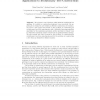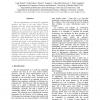BMCBI
2011
13 years 9 months ago
2011
Background: It has been suggested previously that genome and proteome sequences show characteristics typical of natural-language texts such as “signature-style” word usage ind...
JCB
2000
14 years 2 months ago
2000
Multiple sequence alignments (MSAs) are frequently used in the study of families of protein sequences or DNA/RNA sequences. They are a fundamental tool for the understanding of th...
STACS
1999
Springer
14 years 6 months ago
1999
Springer
We present a new technique called balanced randomized tree splitting. It is useful in constructing unknown trees recursively. By applying it we obtain two new results on efficient ...
CCECE
2006
IEEE
14 years 8 months ago
2006
IEEE
In this paper, we introduce new algorithms for selecting taxon samples from large evolutionary trees, maintaining uniformity and randomness, under certain new constraints on the t...
FBIT
2007
IEEE
14 years 8 months ago
2007
IEEE
The tree representation as a model for organismal evolution has been in use since before Darwin. However, with the recent unprecedented access to biomolecular data it has been dis...


